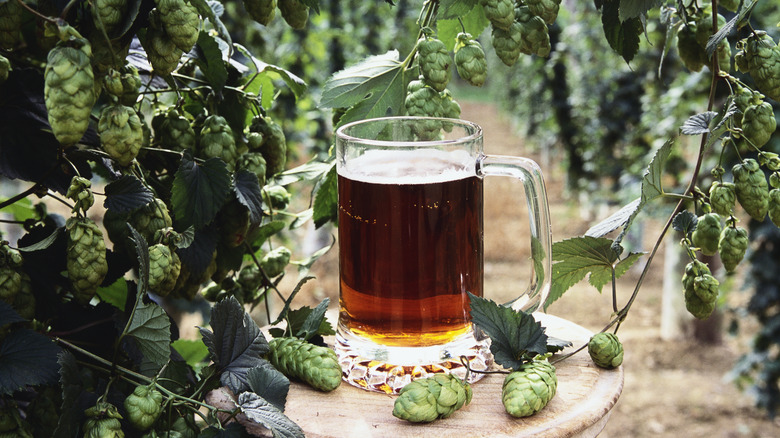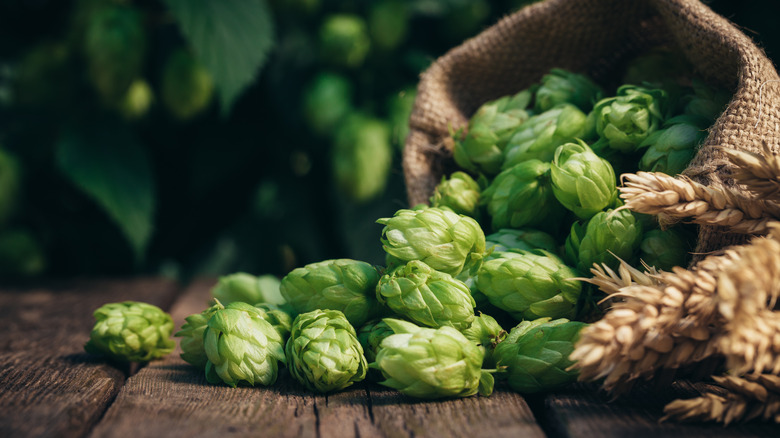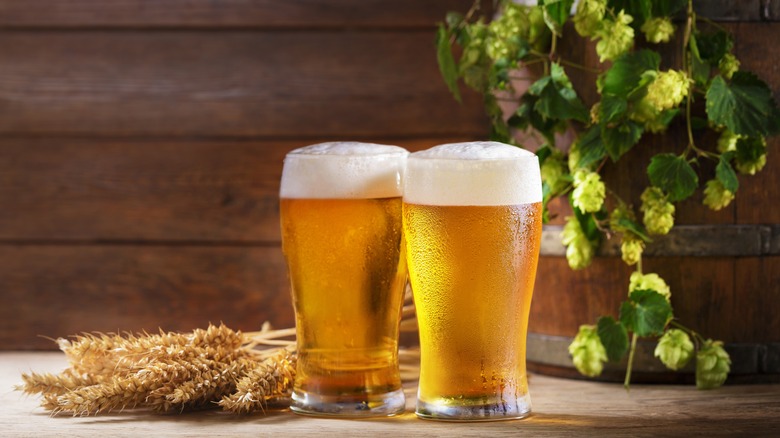The Key Ingredient That Makes Beer Bitter
In today's ever-evolving craft beer market, brews constantly surprise with innovative new flavors. From farmhouse ales made with foraged ingredients to imperial stouts aged in spirit barrels available, it feels like possible beer palates have no bounds. Yet for much of the existence of brewing — soon after beer was likely invented as a mistake — the flavor has been derived from only a handful of ingredients.
Beer's taste comes together through a blend of malts, yeast, and hops. While each ingredient contributes in flavor, the hops in particular deliver an aromatic hit. Hops are full of various acids and oils, many of which contribute bitterness. Bitterness is a flavor note strongly intertwined with beer — for some, a selling point of the booze — and especially prominent in styles like IPAs, barley wines, and strong ales.
Hops aren't only the key to bitterness, though. They also play a part in the overall flavor construction of all beers. The taste of hops contrasts with the sweetness of malts, thereby strengthening the drink's flavor and body. When someone says a beer tastes hobby, they're usually referring to all those factors, not just bitterness. There are no beers crafted without hops, so even if a bitter flavor isn't discernible in a particular brew, those flavored hop compounds are nevertheless involved.
Beer's bitterness arises from hops and a few smaller contributions
The primary contributor to beer's bitterness comes by way of alpha acids, which are a type of terpene found in hops. This acid category occurs naturally in the resin glands of the hop plant, and the longer it's boiled in the wort, the more prominent its flavor. As a result, alpha acid satiated hops are added towards the start of the boiling process, with brewers selecting the quantity and variety to tailor the resultant bitterness.
The freshness of the alpha acids is key. When exposed to direct sunlight, they can cause a beer to develop a skunky profile. And over time, they may lose their flavor entirely. And while found in all beers, such acids are not the sole contributor to bitterness. Other terpenes found in certain hop varieties, imbue further bitterness, too. For example, limonene — which occurs in amarillo, chinook, and centennial hops — delivers bitterness reminiscent of citrus rind.
And it only gets more intricate with further ingredients, too. Malts that are roasted extra dark develop burnt, bitter flavors, which are perceptible in dark styles like stouts. The taste of alcohol can often appear bitter, especially in extra boozy styles. Plus, even the mineral content of the water used in the beer can make an impact on its bitterness.
Bitter beer flavors and the IBU scale differ
Just as the distinction between light and dark beer turns tricky, so does the connection between beer and bitterness. For one, there's a kind of beer that's directly referred to as a bitter style – a low-alcohol English beer that's tasty, and not particularly hoppy. And further complication arises with the IBU scale, short for International Bitterness Units, which was conceived to categorize beer's bitter qualities.
The system was invented in the 20th century to quantify a beer's bitterness, and on paper, it seems straightforward. The IBU number encapsulates the contained amount of alpha acids and other bitterness-inducing compounds on a scale. The scale does help categorize beers — it showcases that a lager and a hop-packed IPA rest on opposite sides of the spectrum. However, it doesn't convey the nuance in taste. A beer can be low in IBUs, but taste bitter, since its alpha acids may be more prominent. Or a high IBU beer might also be filled with malt, which minimizes the bitterness sensed on the tongue. So even though hops are the main contributor to bitterness, they're always mingling with other beer ingredients in complex ways.


